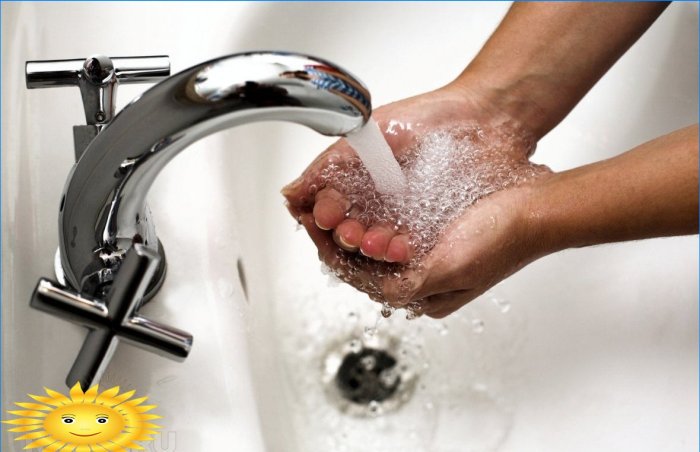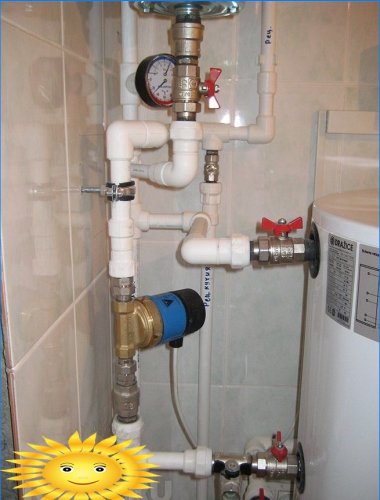Recommendation points
- DHW circulation advantages and scope
- Pumping unit and piping
- Piping system
- Operation and operating modes
Today we will talk about a rather specific engineering system, thanks to which hot water is constantly circulating in the DHW circuit. From the review, the reader will learn what this option is for, how to implement it correctly and provide savings in use..
DHW circulation advantages and scope
Situations are quite widespread when in private houses the entire water treatment system is combined in one technical room, as far as possible from the inhabited area. You can also often find projects of houses with several bathrooms, including on different floors. Such situations are characterized by a significant length of hot water supply pipelines, which promises residents some inconvenience.
For example, when opening a hot water point, it takes time, sometimes a lot, until the water, having flowed through the channels and giving them part of its own heat, begins to flow from the tap at the nominal temperature. This not only causes certain inconveniences with each use of the bathroom, but also leads to overconsumption of water, which serves as a strategic resource in many private construction projects..
The problem is solved by a recirculation unit that maintains a constant flow in the DHW system. Thanks to this, hot water comes out of the tap immediately after opening, moreover, its temperature can be precisely adjusted regardless of the operating mode of the heater. Recirculation units can be completed with those systems in which a storage heater, an indirect heating boiler or a second boiler circuit is responsible for water heating. When using flow-through gas and electric heaters, it is much wiser to move them closer to the draw-off points.
It should be noted that DHW recirculation implies a completely different system topology. Therefore, the implementation of such an idea is possible only during the construction process, or at least major repairs. When trying to modify the existing plumbing complex in order to organize recirculation, it is unlikely that it will be possible to do with a little blood.
Pumping unit and piping
The layout diagram of the recirculation unit may differ depending on the used water heating and pumping equipment. For example, the design of some indirect heating boilers provides for a third outlet from the upper third of the tank to connect a return recirculation pipe. If there is no such outlet, the return flow is connected through a tee to the cold water supply pipe.
An example of a piping scheme for an indirect heating boiler with DHW recirculation: 1 – heating boiler; 2 – safety group of a boiler with an expansion tank; 3 – DHW circulation pump; 4 – safety group for a boiler with an expansion tank; 5 – hot water consumers; 6 – heating radiators; 7 – indirect heating boiler; 8 – boiler circulation pump; 9 – check valves; 10 – heating system circulation pump; 11 – coarse mesh filter
If we take as an example a standard electric water heater with two branches, then a detachable connection with a union nut and a safety group for boilers are first installed on the cold water supply pipe. A tee is mounted below, on two free branches of which ball valves are installed. One of them is designed for connection to the cold water supply line, the other is for the return pipe of the recirculation loop.
DHW recirculation scheme with a storage boiler: 1 – storage water heater; 2 – valve for air suction when draining the tank; 3 – security group; 4 – check valves; 5 – circulation pump; 6 – weekly daily timer; 7 – hot water consumers
Thus, the supply of cold water to the system occurs only when the pressure drops from the opening of the draw-off; in other cases, hot water circulates in a closed loop that includes the entire volume of the boiler. This is the main disadvantage of water heaters, the design of which does not provide for their use in DHW systems with recirculation. With such a connection scheme, the boiler will not properly give 2/3 of its volume with a consistently high temperature, because when making up the entire volume of liquid will be evenly cooled.
As for the pump itself, for these purposes, leading manufacturers of sanitary equipment (Wilo, Grundfos) have developed whole series of devices. Their main difference from standard circulation pumps is threaded connections for connection of the same standard size, which is usually used in domestic water supply systems – for 1/2 “or 1/4” thread. Otherwise, such pumps are almost completely identical to the equipment used in heating systems with forced circulation of the coolant. Additional functions may include capacity control, daily / weekly timer and thermostat.
Piping system
One of the main disadvantages of DHW systems with recirculation lies in their increased material consumption. In addition to the fact that the water supply circuit consists of two pipes, closed in a loop, it is additionally required to provide thermal insulation of the channels in order to restrain parasitic heat leaks within the normal range. But both of these problems are relatively easy to solve..
The best material option for arranging a recirculation system is polyethylene pipes (PEX) with push-in press fittings. Yes, the installation of such systems requires the use of special expensive equipment, but it is quite possible to get by with a set of rented hand tools for crimping. At the same time, in terms of molding, the pipes themselves are much cheaper than polypropylene and metal-plastic ones, and their service life is incomparably higher.
In any case, the pipeline layout is quite simple. The first part of it, supplying water to the plumbing equipment, is mounted in a continuous line from the heating unit in series to each draw-off point. At the last point in the chain, the pipeline does not end, it returns back to the heating unit. This circumstance must be taken into account when considering various laying schemes in order to minimize the consumption of materials for organizing the loop..
Before laying, each individual segment of the pipeline is wrapped in a belt thermal insulation made of expanded polyethylene or rubber. The latter material is more preferable for those pipe sections that will subsequently be walled up. Thermal insulation should be placed close to the fittings, all joints between the shell must be glued with metallized tape.
Operation and operating modes
The opinion that the recirculation system will cause additional energy consumption is not groundless, but in many respects exaggerated. The fact is that during the heating season, when there is the most urgent need for hot water, parasitic heat losses somehow remain inside the thermal circuit of the building, and therefore cannot be considered a pointless waste. In the summer, when there is no need for heating the premises, recirculation can be simply turned off by de-energizing the pump and turning off the tap on the back of the loop. True, for this, the forced circulation device must be placed according to the scheme after all the points of water intake.
Circulation pump with built-in timer and thermostat Wilo Star-Z 15 TT
DHW recirculation can be automated relatively easily. Even if the pump is not equipped with a built-in programmable timer, nothing prevents you from installing a separate control device and turning off the system at night or in the absence of the owners. If the dwelling is equipped with a home automation system, it is possible to establish the operation of the recirculation system based on the algorithms of the “Smart House” or burglar alarm.





DHW recirculation systems are used to minimize water wastage and ensure hot water quickly reaches the faucet. But what exactly is it for and how can it be installed correctly? Are there any specific considerations or steps involved? I’m curious to know more about this technology and its setup. Any experts or experienced individuals out there who can shed some light on this?
Can someone please explain the purpose of DHW recirculation and provide step-by-step instructions on how to properly install it? I’m curious to learn more about its benefits and would appreciate any guidance on the installation process. Thank you in advance!